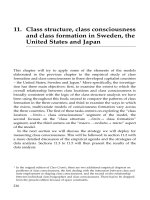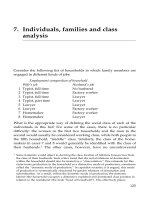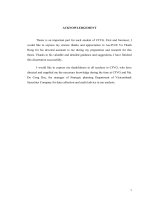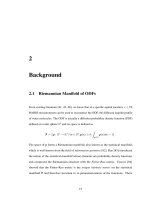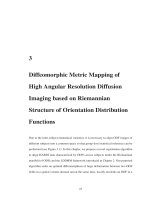Individuals, families and class analysis
Bạn đang xem bản rút gọn của tài liệu. Xem và tải ngay bản đầy đủ của tài liệu tại đây (126.8 KB, 21 trang )
7. Individuals, families and class
analysis
Consider the following list of households in which family members are
engaged in different kinds of jobs:
Employment composition of household
Wife's job Husband's job
1 Typist, full time No husband
2 Typist, full time Factory worker
3 Typist, full time Lawyer
4 Typist, part time Lawyer
5 Lawyer Lawyer
6 Lawyer Factory worker
7 Homemaker Factory worker
8 Homemaker Lawyer
What is the appropriate way of de®ning the social class of each of the
individuals in this list? For some of the cases, there is no particular
dif®culty: the women in the ®rst two households and the man in the
second would usually be considered working class, while both people in
the ®fth household, ``middle'' class. Similarly, the class of the home-
makers in cases 7 and 8 would generally be identi®ed with the class of
their husbands.
1
The other cases, however, have no uncontroversial
1
Some feminists would object to deriving the class location of full-time housewives from
the class of their husbands. Such critics insist that the social relations of domination
within the household should also be treated as a ``class relation.'' One rationale for this
claim treats production in the household as a distinctive mode of production, sometimes
called the ``domestic mode of production.'' In capitalist societies, it is argued, this mode
of production is systematically structured by gender relations of domination and
subordination. As a result, within the domestic mode of production, the domestic
laborer (the housewife) occupies a distinctive exploited and dominated class position in
relation to the nonlaborer (the male ``head of household''). This effectively places
125
solutions. In particular, how should we understand the class location of
married women in the labor force when their jobs have a different class
character from that of their husbands? Intuitively, it seems that a typist
married to a factory worker is not in the same class as a typist married to
a lawyer, even if the jobs of the two typists are indistinguishable. And
yet, to simply say that the second typist is ``middle'' class seems to
relegate her own job to irrelevance in class analysis. In class terms she
would become indistinguishable from the woman lawyer in case 5. And
what about the woman lawyer married to a worker? It seems very odd to
say that she is in the same class as the typist married to a factory worker.
Many feminists have strongly objected to equating a married woman's
class with her husband's, arguing, to use Joan Acker's (1973) formula-
tion, that this is an example of ``intellectual sexism.'' And yet, to identify
her class position strictly with her own job also poses serious conceptual
problems. A typist married to a lawyer is likely to have a very different
life style, and above all very different economic and political interests
from a typist married to a factory worker.
Of course, if these kinds of ``cross-class'' household compositions were
rare phenomena, then this issue of classi®cation would not have great
empirical importance, even if it still raised interesting theoretical issues.
However, as we saw in chapter 5, the kinds of examples listed above are
not rare events: in the United States (in 1980) 32% of all married women
employed in expert manager jobs have husbands in working-class jobs,
and 46% of men in such expert manager jobs whose wives work have
wives employed in working-class jobs. Class heterogeneous families are
suf®ciently prevalent in contemporary capitalism that these problems of
classi®cation cannot be ignored in class analysis.
The central purpose of this chapter is to try to provide a coherent
conceptual solution to this problem of identifying the class location of
married women in the labor force and then to deploy this solution in an
empirical analysis of the relationship between class location and sub-
jective class identity in the United States and Sweden. There are two
basic reasons why I think solving this problem of classi®cation is
important. First, as a practical matter, if one is doing any kind of research
in which the class of individuals is viewed as consequential, one is
forced to adopt a solution to this conceptual problem if only by default.
housewives in a distinctive class in relation to their husbands. A housewife of a
working-class husband is thus not ``in'' the working class as such, but in what might be
termed ``proletarian domestic labor class.'' One of the best-known defenses of this view
is by Christine Delphy (1984: 38±39).
Class counts126
Survey research on political attitudes, for example, frequently examines
the relationship between an individual's class and attitudes. Typically,
without providing a defense, attributes of the job of the respondent,
whether male or female, are used to de®ne class. Like it or not, this
implies a commitment to the view that the class of individuals is
appropriately measured by their own jobs regardless of the class
composition of their households.
More substantively, this problem of classi®cation raises important
issues concerning the underlying explanatory logic of class analysis. By
virtue of what is a person's class location explanatory of anything? Is it
because class identi®es a set of micro-experiences on the job which shape
subjectivity? Even though they are not dealing with the problem of class
and gender, this is essentially the argument of Melvin Kohn (1969) in his
numerous studies of the effects of the complexity of work on cognitive
functioning and of Michael Burawoy (1985) in his research on consent
and con¯ict within work. If one adopts this job-centered view of the
mechanisms through which class matters, then household class composi-
tion becomes a relatively secondary problem in class analysis. On the
other hand, if one sees the central explanatory power of class as linked to
the ways in which class positions shape material interests then house-
hold class composition becomes a more salient issue. Resolving this issue
of classi®cation, therefore, is bound up with clarifying the mechanisms
through which class is explanatory.
In the next section of this chapter, I will brie¯y review the discussion
in the 1980s of the problem of de®ning the class location of married
women. In section 7.2, I will elaborate an alternative approach built on
the distinction between direct and mediated class relations brie¯y
discussed in chapter 1. Section 7.3 will then use this distinction to
develop a concrete set of predictions about the linkage between class
location and class identity in Sweden and the United States. Section 7.4
will present the results of the analysis.
7.1 The debate on women and class
These empirical and theoretical issues on the class analysis of women
were crystallized in a debate launched in 1983 by John Goldthorpe's
controversial essay, ``Women and Class Analysis: in Defense of the
Conventional View.'' Goldthorpe endorses the conventional view that
the class of women is derived from the class of their husbands:
127Individuals, families, class analysis
. . . the family is the unit of strati®cation primarily because only certain family
members, predominently males, have, as a result of their labour market partici-
pation, what might be termed a directly determined position within the class
structure. Other family members, including wives, do not typically have equal
opportunity for such participation, and their class position is thus indirectly
determined: that is to say, it is ``derived'' from that of the family ``head'' . . .
Moreover, the authors in question [traditional class analysts] would not regard
their case as being basically affected by the increase in the numbers of married
women engaged in paid employment. They would emphasize that although the
degree of women's economic dependence on their husbands may in this way be
somewhat mitigated, such employment typically forms part of a family strategy,
or at all events, takes place within the possibilities and constraints of the class
situation of the family as a whole, in which the husband's employment remains
the dominant factor. (Goldthorpe 1983: 468±469)
Goldthorpe's paper sparked a lively, if sometimes overly polemical
series of exchanges. Goldthorpe's critics (e.g. Heath and Brittain 1984;
Stanworth 1984) argued that the class character of the jobs of married
women in the labor force has signi®cant effects independently of the
class of their husbands, and, as a result, those families within which
husbands and wives occupy different job-classes should be treated as
having a dual-class character.
Goldthorpe (1984) replied by arguing that treating families as having a
cross-class composition risks undermining the coherence of class ana-
lysis and subverts the explanatory capacity of the concept of class. Since
class con¯icts run between families, not through families, if families are
treated as lacking a unitary class character, class structure will no longer
provide a systematic basis for explaining class con¯icts.
Goldthorpe's argument can be broken down into two primary theses:
1 Unitary family-class thesis: Families pool income as units of consump-
tion. This means that all family members bene®t from the income-
generating capacity of any member. Consequentially, all family
members have the same material ± and thus class ± interests. As a
result, it is in general families, rather than atomized individuals, that
are the effective units collectively organized into class formations.
Class struggles occur between families, not within families.
2 Husband's class derivation thesis: Because of the gender division of labor
in the household and male dominance in the society at large, the
economic fate of most families depends much more heavily upon the
class character of the husband's job than of the wife's. In family
strategies of welfare maximization, therefore, in nearly all cases the
class-imperatives of the husband's job will overwhelmingly pre-empt
Class counts128
strategic considerations involving the wife's job. As a result, the
causally effective class of married women (i.e. the class that has any
explanatory power) is in general derived from the class location of her
husband.
Goldthorpe, of course, does not deny that by and large individuals
rather than families ®ll jobs in capitalist economies. What he disputes is
the claim that the class structure should be treated as a relational map of
the job structure. Instead, classes should be de®ned as groups of people
who share common material interests. While it may be the case that the basic
material interests of people depend upon their relationship to the system
of production, it need not be the case that those interests depend
primarily upon their individual position within production (i.e. their
``job''). Insofar as families are units of consumption in which incomes
from all members are pooled, then all members of the family share the
same material interests and thus are in the same class, regardless of their
individual jobs. Individual family members would occupy different
locations in the class structure only when it is the case that the family
ceased to genuinely pool resources and act as a unit of consumption
sharing a common fate.
A number of interconnected criticisms can be leveled against these
theses. First, while it may be true that all family members bene®t from
income brought into the household, it does not follow from this that they
all share a unitary, undifferentiated interest with respect to such income.
To claim that wives and husbands have identical interests with respect to
the gross income of the family is somewhat like saying that both workers
and capitalists have an interest in maximizing the gross revenues of a
business ± which is frequently true ± and therefore they are in the same
class ± which is false. Families may pool income, but there is evidence
(e.g. Sorensen and McLanahan, 1987) that this does not mean that
husbands and wives always share equally in the real consumption
derived from that income.
Inequality in the consumption of family income by husbands and
wives, of course, does not necessarily mean that married women in the
labor force have material interests in their own individual earnings as
such, and thus distinct individually based class interests in their jobs. It
could be the case that they have gender interests in a redistribution of
power within the household, but that they still lack any autonomous
class interest in their own earnings independently of the family income
as a whole. There are, however, two reasons why it is plausible to see
129Individuals, families, class analysis
married women as having individual class interests linked to their own
earnings. First, the high rates of divorce in contemporary capitalist
societies means that the jobs of many women in the labor force constitute
for them a kind of ``shadow class'' ± the class they would occupy in the
face of marital dissolution. Given the relatively high probability of such
events, married women have personal class interests in the earnings
capacities they derive from their individual jobs. Secondly, there is
evidence that the proportion of the family budget brought in by the wife
affects her bargaining power within the family. Even if the family pools
income, therefore, married women would have some autonomous per-
sonal interests in their own earning capacity in their paid jobs.
A second general criticism of Goldthorpe's argument concerns his
very narrow understanding of class interests. The unitary family class
thesis rests on the claim that since husbands and wives pool income,
they have identical interests with respect to overall family earnings
capacity and thus identical class interests. The interests that are tied to
classes, however, are not simply income-based interests. At least if one
adopts a broadly Marxist concept of class, issues of autonomy, the
expenditure of effort and domination within work are also systematically
linked to class. These kinds of interests are at the heart of what Burawoy
(1985) has called the ``politics of production'' and center much more
directly on individuals as job-holders than as members of household
units of consumption. Even if married couples share a unitary family
consumption class, the potential differences in their job-classes could still
generate differences in their class interests.
Third, contrary to Goldthorpe's view, it is not inherently the case that
families rather than individuals are mobilized into class struggles. While
this may generally be the case, especially in situations where families are
class-homogeneous, it is possible to imagine circumstances in which a
wife is a union member engaged in union struggles of various sorts and
her husband is a manager or petty bourgeois generally opposed to
unions. Particularly if class interests are seen as broader than simply
interests in income, one can imagine husbands and wives in different
job-classes, involved in organizations supporting quite different kinds of
class interests. To be sure, it would be extremely rare for husbands and
wives to be actively on ``opposite sides of the barricade'' in a given class
struggle ± for the husband to be a top manager or employer in a ®rm in
which his wife was on strike. But this does not imply that in other
contexts they could not be involved in quite distinct and even opposing
kinds of class formations.
Class counts130
Finally, Goldthorpe argues that because the economic fate of the
family is more dependent upon income from the husband's job than the
wife's, the class location of the family should be exclusively identi®ed
with his job. This assumes that in the strategic choices made within
families over labor market participation and job choices there is minimal
struggle, negotiation and bargaining, and as a result the interests linked
to the husband's job always pre-empt those of the wife's job. Family
strategy, in this view, is not some kind of negotiated weighted average of
the class-based imperatives linked to each spouse's job, but uniquely
determined by the class imperatives of the male breadwinner.
This claim by Goldthorpe is simply asserted on his part, unbacked by
either theoretical argument or empirical evidence. Of course, there are
many cases where a story of this sort has considerable face validity.
There are undoubtedly families in which the husband is in a well-paying
managerial or professional job with a systematic career structure while
the wife holds part-time ¯exible work to which she has little commit-
ment. In such situations it might well be the case that whenever there is a
trade-off between interests tied to the wife's job and the husband's job,
both parties agree to adopt a strategy supporting the husband's interests.
In such a situation, it may be reasonable, at least as a ®rst approximation,
to identify the family-class exclusively with the husband's job. But there
is no reason to assume that this particular situation is universal. It is
much more plausible to suppose that there is systematic variation across
families in such strategic balances of interests and power, and thus that
the relative weight of different spouse's job-classes in shaping the class
character of the family as a whole is a variable, not a constant.
In 1980, in roughly 10% of all two-earner families in the United States
the wife earns 40±49% of the family income and in 25% of all two-earner
married couples she contributes 50% or more of the total family income.
In Sweden, the ®gure is even higher: 45% of respondents in two earner
families report the wife contributes ``about 50%'' of the income and 10%
report that she brings in 75% or more of the income. Certainly in such
families, even from a narrow economic point of view, the family
strategies should be affected by the class-character of both spouses' jobs.
Furthermore, even when it is the case that in decisive zero-sum trade-off
situations, interests derived from the husband's job usually pre-empt
those of the wife's, it does not follow from this that in other situations
the interests linked to the wife's job are irrelevant and do not shape
family income maximization strategies. Even where the wife contributes
less than the husband, therefore, the class character of her paid work
131Individuals, families, class analysis
could systematically shape family strategies, and thus the class character
of the family unit.
If these criticisms are correct, then one is unjusti®ed in simply equating
the class location of married working women with the job-class of their
husbands. But it also seems unsatisfactory to treat their class as simply
based on their own immediate work. Some other conceptual solution to
de®ning their class must be found.
7.2 An alternative approach: direct and mediated class locations
Most class concepts view class structures as a set of rooms in a hotel
®lled by guests. The dwellers may be individuals or families, and they
may change rooms from time to time, but the image is of ``empty places''
being ®lled by people. There is, however, an alternative general way of
understanding class structure: instead of a set of rooms, class structures
can be understood as a particular kind of complex network of social
relations. What de®nes this network of relations as a class structure is the
way it determines the access of people to the basic productive resources
of a society and the processes of exploitation, and thus shapes their
material interests. A ``location,'' then, is not a ``room'' in a building, but a
node in a network of relations.
In a highly simpli®ed model of the world we can reduce such a
network of social relations to a single link between individuals and
productive resources constituted by their direct, personal control or
ownership of such resources. This is the abstraction characteristic of
most Marxist class analysis. But there is no reason to restrict class
analysis to such simpli®cations. The material interests of real, ¯esh-and-
blood individuals are shaped not simply by such direct, personal
relations to productive resources, but by a variety of other relations
which link them to the system of production. In contemporary capitalist
societies these include, above all, relations to other family members (both
within a single generation and intergenerationally) and, perhaps, rela-
tions to the state. I will refer to these kinds of indirect links between
individuals and productive resources as ``mediated'' relations, in con-
trast to the ``direct'' relations embodied in the individual's immediate job
and personal ownership of productive resources.
For certain categories of people in contemporary capitalism, location
in the class structure is entirely constituted by mediated relations. This is
most clearly the case for children. To say that children in a working-class
family are ``in'' the working class is to make a claim about the ways in
Class counts132


